How Long Does It Take to Install a Sump Pump?
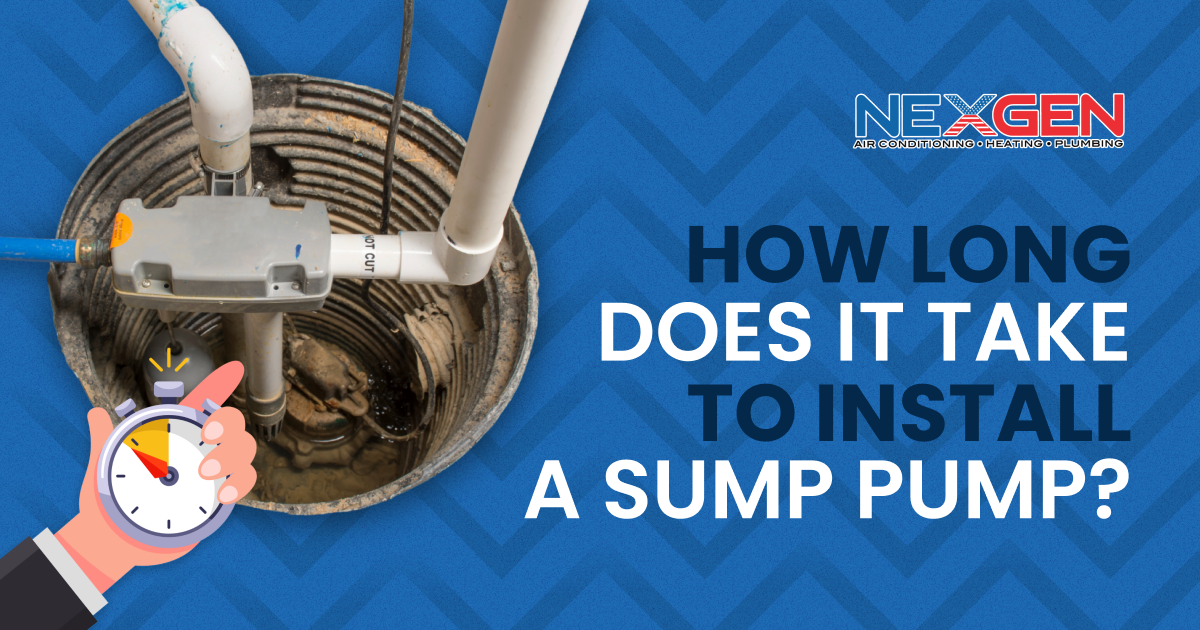
Sump pump replacement can take 2 to 4 hours; however, a first-time sump pump installation can take as long as 8 hours. A plumbing professional can install a sump pump faster than most DIYers. Taking on the project yourself can result in various problems, but we’ll look at the general process of installing a sump pump in your home.
How to Replace a Sump Pump
On average, sump pumps last about 10 years. If the system turns on and off too often, makes grinding or rattling noises, or is rusty or corroded, it should be replaced. Sump pump replacement can be a complex job with many roadblocks. A professional plumber is equipped to deal with any unexpected issues during the process.
So, you’ve set aside time to consider a DIY sump pump install. Before you attempt the installation yourself, let’s look at an overview of what must be done:
- Gather Your Tools: You’ll need a bucket (or a shop vac for removing water), a drill with a 3/16” bit, a hacksaw, primer/PVC cement, adjustable pliers, an adjustable pipe wrench, a rubber coupling boot, and zip ties. Tools can be purchased and often rented. If you don’t have them, determine if this is cost-effective.
- Remove the Old Sump Pump: Disconnect the power and then the check valve so the water can drain. Remove the old unit, allowing excess water to drain into the bucket. Clean out the pit, remove debris, and check that the bottom of the sump pit has a hard, level bottom. The base should be made of concrete or brick; setting the new pump on dirt or gravel can cause it to jam or wear prematurely.
- Connect the Check Valve and Discharge Pipe: Prime the inside of the fitting and the outer edge of the pipe (if using a glue-in valve). This ensures the glue will bond the two components strongly. Slide the coupling over the piping and attach the fitting. Then apply PVC cement to the inside of the fitting and push and twist the fitting onto the pipe.
- Measure the Pit: The sump pit’s diameter should be larger than 14 inches. This ensures the float switch fits and can function properly. The pit should be at least 22 inches deep. Also, check the distance from the bottom of the check valve to the base of the pit and the height from the ground to the center of the discharge pipe’s threading. When cutting the PVC pipe, cut it a few inches longer with the hacksaw, allowing for final cuts later if needed.
- Connect the Adapter and PVC Pipe: The male-threaded adapter is now glued to the pipe. Using the primer and PVC cement, attach the adapter to one end and thread the adapter end of the pipe onto the pump. Tighten it with a wrench. Overtightening it can cause the fittings to crack.
- Test the Sump Pump: Before fitting the pump in the pit, plug the system in and move the float, allowing the unit to run for a few seconds. If you hear the pump running, switch the float. Don’t let it continue to run dry.
- Drill the Weep Hole: Holding the pump at an angle, measure about two finger-widths above the adapter and drill a hole. The drill should be held at a 45-degree angle. The weep hole allows for water drainage and prevents damage caused by water flowing back into the pit.
- Cut the Pipe: Cut the PVC pipe while it’s elevated. Use a crate or other object to lift it off the ground. The pipe should be a few inches longer than the length you previously measured. Remove any frayed plastic with a utility knife.
- Place the Pump in the Pit: Take final measurements to ensure the discharge pipe fits under the check valve. Use towels or rags to soak up any water. Lift the pipe, cut it to its final length, drop the pump back in, and connect the piping. To test the system, fill the pit with water and see if the pump turns on and that the check valve closes when it turns off.
What to Know for a First-Time Sump Pump Installation
A sump pump is designed to keep water and moisture out of your basement. You’ll first need to decide on the type of system to install. A submersible sump pump is the most common type, and it is usually installed as your home is being constructed. It sits in a sump pit within a waterproof housing. A pedestal sump pump sits above the floor and has a motor and hose that lead to the pit; it’s often installed after a home is built and moisture issues have been identified.
When installing any sump pump, make sure it is upright to avoid flooding. Also, make sure all pipes and hoses are tight and follow the manufacturer’s guidelines for periodically cleaning the unit. Also, check for holes or damage that can prevent water from flowing away.
Should I Consider DIY or Professional Sump Pump Installation?
As you can see, sump pumps can be challenging and time-consuming to install (if you have no experience, you can waste several hours or days). Unexpected issues can lead to damage and costly repairs. An experienced technician can install a new unit or complete a sump pump replacement in a shorter time and enable your investment to last longer. They can also make sure all connections are secure to avoid flooding and other unexpected issues.
Contact NexGen
NexGen is the leading plumbing services company in Southern California. We quickly install and replace sump pumps in homes prone to basement flooding, high humidity, mold, or sewage backups. If you live in an area that floods often, let us determine if a sump pump would help. Our trained professionals also provide equipment repairs and maintenance. For a free sump pump installation or replacement estimate, call (805) 301-6788 today.
6 Signs It's Time to Replace Your Old Furnace
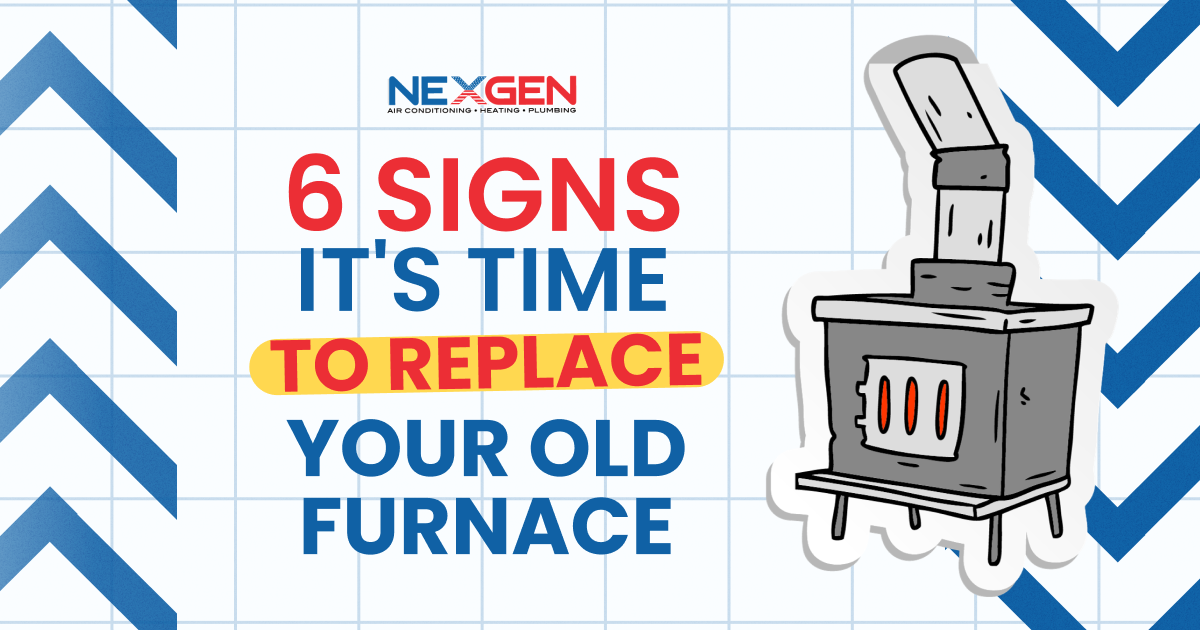
Sooner or later, it’ll be time to replace your furnace and stop paying for costly repairs. But deciding on furnace replacement isn’t always simple. There are often repair options, but while many issues can be fixed, an older furnace runs less efficiently and will likely need more repairs in the future.
A furnace can last 15 to 30 years (a gas furnace’s lifespan maxes out at about 20 years). Even if you’ve followed all maintenance recommendations and taken steps that help prolong its lifespan, here are six signs your old furnace should be replaced:
1. Loud Noises During Operation
Loud noises mean your furnace needs to be repaired or replaced. Consider purchasing a new unit if the noises return soon after a repair, don’t go away, or signal the end of the furnace’s life. While popping sounds are caused by temperature fluctuations (and should be checked if they get louder and more frequent), the following noises are of concern:
- Rattling: Loose components may be vibrating and hitting against each other; an HVAC contractor will discuss replacing the unit if multiple components are affected.
- Loud Humming: If the ordinary hum of the blower motor becomes increasingly louder, it’s time to invest in a new system.
- Screeching: Your old furnace may have a broken blower motor, belt, or pulley that’s caused more damage.
- Clicking: The flame sensor or ignitor may need to be repaired, but furnace replacement may be suggested if there are other issues present.
- Booming: This is indicative of ignition delays and can be a sign of gas emissions. If the sound is accompanied by a lingering gas odor, replace your furnace.
2. Every Room Is a Different Temperature
If each room in your home has its own microclimate (hotter or cooler than the other), your furnace may be unable to distribute heat properly. Start researching new furnaces if your heating system is aging. A 15-year-old or older furnace often becomes less efficient. Significant temperature differences between upper and lower floors indicate this is the case.
3. The System Is Blowing Cold Air
Check the thermostat to ensure it’s in “Heat” mode and set at the desired temperature. Unless the thermostat is set incorrectly, cold air from vents means your heating system is malfunctioning. A simple issue like a dirty air filter is easily fixed. But if installing a new filter doesn’t help, or a technician finds multiple issues with your old furnace, it should be replaced.
4. The Cost of Ownership Is Skyrocketing
If your furnace is struggling to heat your home, it may work harder to compensate. Or, mechanical or electrical issues are wasting energy. These issues can cause your energy bill to increase suddenly.
Frequent repairs are another reason to replace your furnace. If you’re paying for emergency service calls, parts, and labor every few months, furnace replacement may be more cost-effective over time. One way to determine if it’s not worth fixing is to multiply the repair cost by the unit’s age; if you get a number over 5,000, repairs may be too expensive.
5. Dust and Soot Are Everywhere
Dust and soot on or near the register, or collecting in parts of your home, is a sign your furnace is on its last leg. Soot buildup is a sign of increased carbon dioxide production. It can block airflow through the register and also damage furniture, shelves, and wood flooring, especially if it’s accompanied by dry air. Dead plants are a sign of low moisture levels. Consult a professional regarding furnace replacement if soot or dirt is a problem.
6. The Burner Flame Is Yellow
Your furnace should have a clean blue flame. If the flame turns yellow, there may be a gas leak or issue with the combustion process. It can also indicate the furnace is releasing carbon monoxide, which can cause headaches, dizziness, and breathing problems; the colorless, odorless gas is deadly in high concentrations. Call for help if the flame changes color and/or you smell gas in your home.
Call NexGen for a Furnace Replacement Consultation
Throughout Southern California, our fully licensed and insured technicians provide high-quality furnace repair and replacement. We’re available 24/7 for emergencies. If furnace replacement is the best option, then we’ll perform a free evaluation of your home and a free estimate. High-efficiency equipment (including heat pumps), financing options, and extended warranties are available. NexGen also offers a comprehensive monthly maintenance plan that delivers a wide range of benefits. To learn more or schedule furnace/heat pump installation or replacement in Los Angeles, Orange County, or the Inland Empire, call (805) 301-6788.
8 Reasons Why You Shouldn't Install Your Own Furnace
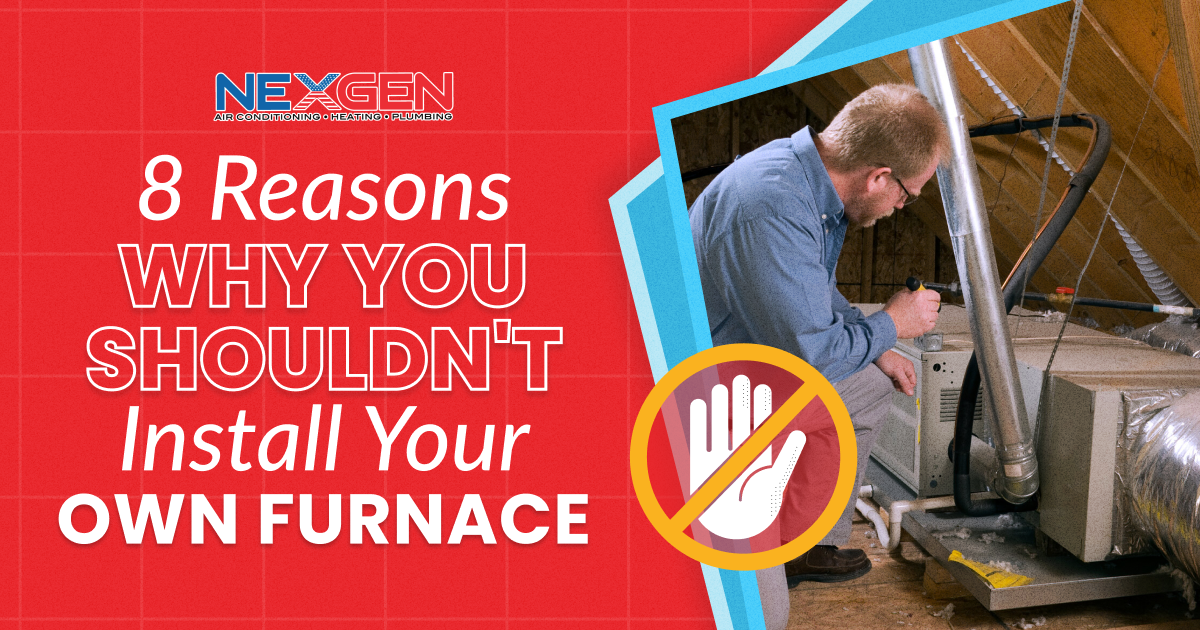
There are many reasons not to install a furnace yourself. Perhaps you just purchased a new home, built one from the ground up, or must suddenly replace your old heater while balancing other expenses. A DIY furnace installation won’t save you money. It can also be extremely dangerous. As a general rule, you should always hire a licensed and trained contractor for furnace installation.
Here are 8 reasons not to install your own furnace:
1. Do You Have What You Need?
Some manufacturers supply furnaces to wholesalers, but not many. Furnace manufacturers and suppliers rarely sell heating equipment directly to consumers. Most of them work directly with HVAC installers, so product availability (and finding a reputable source) can be a problem.
An experienced technician knows where to find the right equipment and likely has a business relationship with a reputable supplier. In addition, other parts, such as gas connection fittings, exhaust pipes, a condensate pump, and a drain line may be needed, even if replacing the old unit with the same type. And, you’ll need tools like pliers, screwdrivers, drills, hammers, multimeters, tube cutters, and others (the exact equipment required depends on the furnace model).
Given the complexity of furnace installation and everything needed to accomplish it, you should never attempt it yourself.
2. Some DIY Work Can Be Illegal
Every state has its own rules and regulations. In California, installing a furnace or other major HVAC component requires pulling a building permit, which is issued by the city or county. A permit ensures a project is inspected and meets safety and structural standards. Generally, only a professional installer has the access and resources to obtain a permit, especially when installing a gas-powered appliance.
As a homeowner, you could also pull the permit. However, any agency overseeing the process will see you as the contractor. You’ll be liable for any issues with the installation (the municipality may require you to start over if there are questions about compliance, costing time and money). A contractor is familiar with the installation and inspection process, so they’ll approach the project with every legal requirement in mind.
3. A Professional Knows How to Hook Up a Furnace
From shutting off the old system to removing it to connecting the new furnace, a professional contractor understands the entire process. Installation also often involves custom cutting and fitting pipe, duct, and vent connections and ensuring everything is properly sealed. Do you know the best-sized PVC pipe for the exhaust or the right lengths and fittings for the gas connection? Or, do you have the proper wiring or electrical capacity for a new electric furnace? Forgetting or skipping any of these considerations can have dire consequences.
4. A Furnace Must Be Sized Properly
Most homeowners who try to install their furnaces don’t know how to perform a load calculation. Improper sizing can result in inefficient heating; plus, it can strain a furnace, leading to frequent repairs or early replacement. A trained contractor can determine the best-sized furnace based on the square footage of your home, the number of rooms, window sizes, the quality of insulation, and many other factors. The size and condition of ductwork are also important considerations.
5. Furnaces Require a Solid Gas or Electrical Connection
Hooking a furnace up to a natural gas line requires a permit. Any mistakes can lead to a gas leak that can trigger an explosion and destroy your home. Using the wrong fittings or not properly securing connectors with the right tools can have devastating results. Professionals have the tools to secure and seal gas lines and detect potential leaks.
No matter what type of furnace you have, the electronics, blower, and ignition system require electricity. In most cases, the heater requires a dedicated circuit. A technician can install one and configure the hot, neutral, and ground wires. They also know where to mount the switch and other control features.
6. Thermostat Wiring Mistakes Can Affect Efficiency and Control
If you’ve never attempted furnace installation before, chances are your knowledge of thermostat wiring is limited. The more complex a thermostat, the more wires it has. Even a basic modern system may have up to four wires and those with advanced controls, multi-stage heating and cooling, etc. may require as many as 10 wires. Each wire must be fit into the correct terminal for the system to run properly.
7. DIY Furnace Installation Can Void the Warranty
Furnace manufacturers typically require a professional to install their equipment. This is often explicitly stated in the terms of the warranty. Therefore, installing a furnace yourself can void the warranty, which can have costly consequences if you make a mistake or something randomly goes wrong. You’ll have to pay the full cost of repairing or replacing the unit.
Also, your home insurance may not cover damage due to DIY furnace installation. Or, the company can cancel your policy if it finds out the work was done without a permit.
8. The System Can Malfunction and Require Costly Repairs
A good reason to hire a professional installer is they’ll ensure your furnace works. The slightest mistake or lack of precision can lead to combustion problems, which can prevent the unit from effectively heating your home. These can also cause carbon monoxide leaks, which can lead to illness and death. The system can be strained by operational, ventilation, and air distribution problems as well, so it may require frequent and costly repairs, erasing any savings you thought you’d achieved with a DIY installation.
Hire NexGen for Professional Furnace Installation
NexGen is a residential heating installation and replacement company serving Southern California. Fully licensed and insured, our technicians install many types of heating equipment, including single- and two-stage multi-speed units and modulating variable-speed systems. Comprehensive maintenance plans and extended warranties are available. To request professional furnace installation and a free evaluation and estimate, contact us online or call (805) 301-6788 today.
Furnace Sounds You Shouldn't Ignore
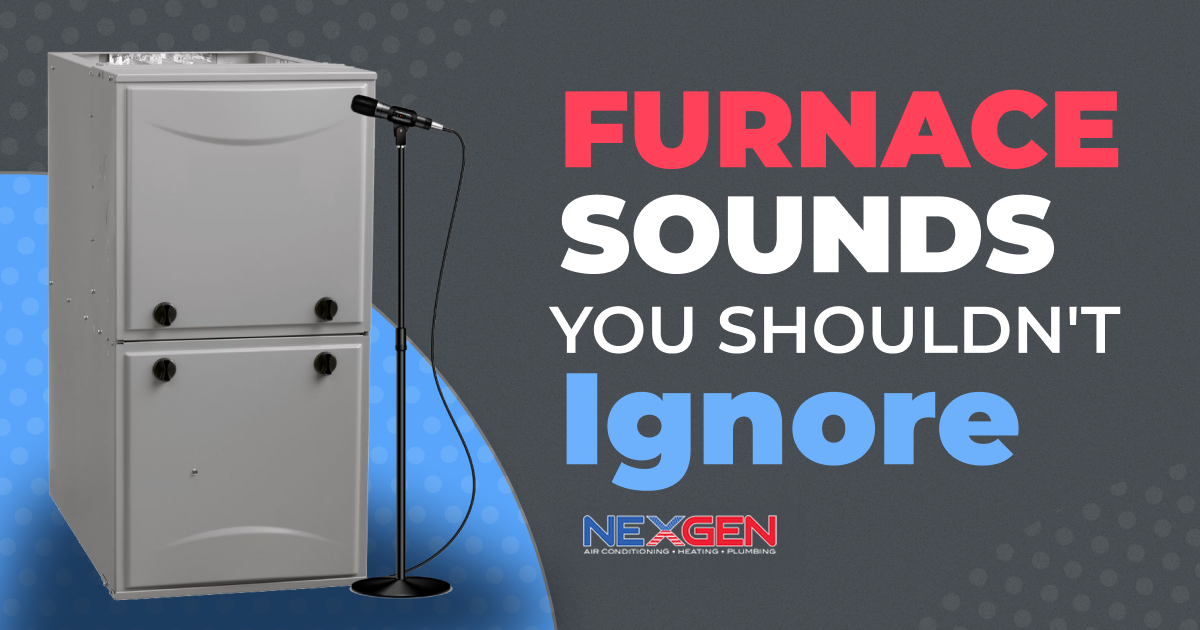
There are specific furnace sounds you should never ignore. Hearing unusual noises should prompt you to call a heating technician. NexGen provides furnace repair near you anywhere in Southern California. Our trucks are dispatched from locations in Anaheim, Northridge, Riverside, and Palm Desert. When you hear something strange from your furnace, you can reach us 24/7 and our licensed and insured technicians can troubleshoot and fix it fast.
Call for help if your furnace makes any of the following sounds:
Scraping
If it sounds like metal scraping on metal, the furnace’s blower wheel may be broken or some component has come loose. A malfunctioning blower wheel can damage the motor and waiting any longer can mean requiring a new blower assembly. Other damage to your furnace can also occur. Therefore, acting quickly can mean the difference between a fast and simple fix and an expensive repair.
Popping or Banging
If your furnace makes popping or banging sounds, the burners may be dirty. A coating of dirt causes a delayed ignition; gas builds up and creates a small explosion, creating unsettling noises. Ignoring these sounds can lead to explosions that become strong enough to crack the heat exchanger. Call for help even if the noise is more like a rumbling, knocking, or booming.
Popping noises can also come from air ducts as they expand and contract. This happens as the furnace turns on and off, so the sound may not mean it’s at risk of failing. However, there may be a ductwork issue, such as an improperly sized or poor-quality duct, that requires a professional. Or, the issue can be as simple as a clogged filter or closed vent.
High-Pitched Squealing
A squealing noise from a furnace can be caused by a few things. Usually, it’s a worn-out part, such as a frayed blower belt or a failing blower motor. A professional can easily fix these, but waiting can lead to further damage and major repairs.
Whistling
A problem with the gas valve can cause whistling noises while the furnace is running. Call an HVAC company that provides furnace repair near you, as fitting a new gas valve requires a trained professional. If the sound isn’t coming from a valve, it may be due to an airflow issue in a duct or vent. Open vents or change the filter if this seems to be the source; call for help if the noise doesn’t go away.
Rattling
Rattling noises can point to various issues. The cause may be a loose bolt in the access door, which can be tightened with a wrench. If your furnace is getting old, rattling can come from a bad blower motor fan belt, a damaged burner, or a cracked heat exchanger. Call a technician to diagnose the problem quickly, save your furnace, and prevent any safety hazards.
Chirping
A furnace might make a chirping sound when you first turn it on for the season. Although it’s not unusual, a chirp can mean the blower motor pulley is misaligned or the blower wheel is touching the mounting plate. Call a professional if the noise doesn’t go away after the furnace starts up. It’s likely some kind of trouble is brewing.
Flapping
An object, which may be as small as a piece of paper, may be stuck in the air intake. There are several places where it can get trapped. To fix this problem, a technician will need to get inside the furnace system.
Are There Normal Sounds a Furnace Can Make?
A quick pop or click as the furnace starts and a dull hum as it’s running aren’t concerning. You can expect to hear some noise as the unit starts up, runs, and shuts off.
Can I Hear If I Need a New Furnace?
Loud rattling, grinding, scraping, rumbling, screeching, and other unusual noises can mean your furnace is about to give out. A heating technician can check the system to determine if this is the case.
How Do You Fix a Noisy Furnace?
Tightening loose parts, fixing damaged insulation, and opening vents can resolve furnace noise. Lubricating the motor and other moving parts can too. If you can’t find the source of the noise or resolving it requires repairing your furnace, call a professional.
Call NexGen for Furnace Repair Near You
The #1 heating repair company in Southern California, NexGen has fully licensed, bonded, and insured technicians that can handle any problem. They can find the source of any furnace sounds you shouldn’t ignore. Whether the unit needs a new fan blade, igniter, or other part, our contractors arrive with everything needed to resolve the issue. We’re also available 24/7 if you have an emergency. Call (805) 301-6788 to request help.
Why Does a Furnace Cost So Much?
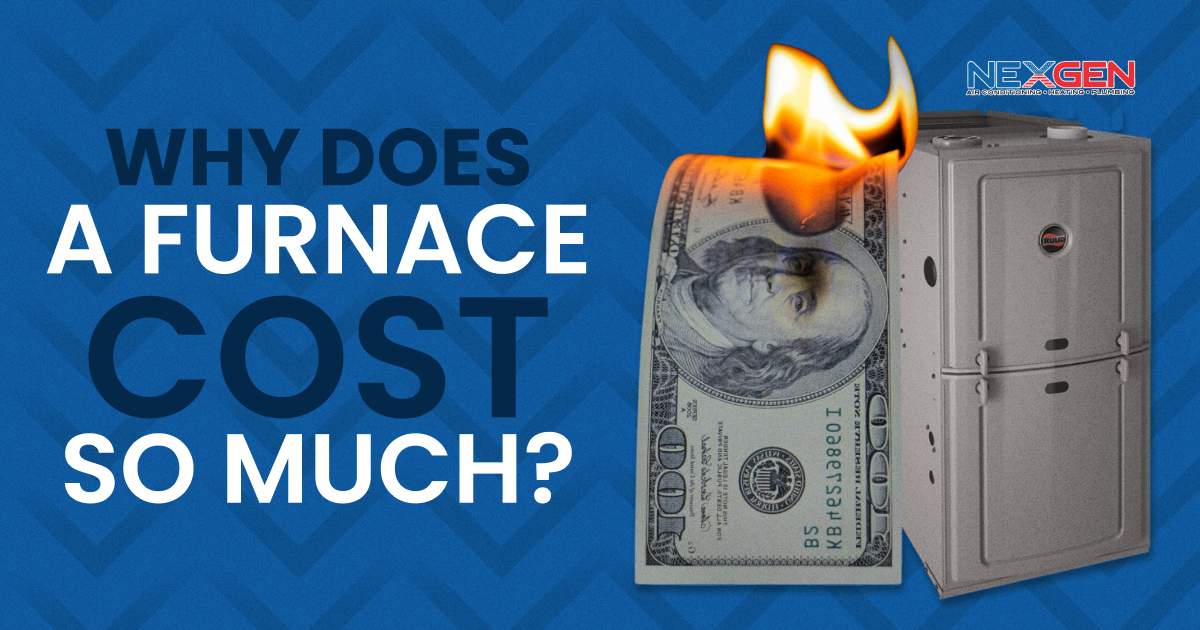
Many people ask us why a furnace costs so much. According to Forbes, installing a furnace costs $4,700 on average (in 2023 dollars), but you could spend less or as much as $10,000 depending on the type of appliance.¹ It’s important to realize a furnace is a long-term investment. It can last for 15 years, but if you’re diligent enough with scheduling maintenance and heating services, a 20-year-old furnace isn’t unheard of. But what makes the upfront costs of furnace installation so expensive?
Here’s a look at why a furnace is often such a big investment.
Heating Company Profit
The upfront cost is less dramatic when the longevity of the equipment is considered. However, companies that sell furnaces don’t benefit as much. That’s because they must wait longer before you need a new one, and they sell only a few furnaces over any given time. Selling furnaces that last is good for a company’s reputation. But it must earn as much as possible on each sale. Therefore, high selling prices can be hard to avoid.
Furnaces Are Complex
A furnace is a complex assembly of parts and components. Each one has differences and every home has unique installation requirements. There may also be space constraints and gas, electrical, or ventilation upgrades to make.
The type of furnace matters, too. An electric furnace costs from $2,000 to $7,000; operating it requires paying high electricity prices each month. Furnaces use a lot of electricity. However, a natural gas furnace can cost $3,800 to $10,000 to install, while natural gas is generally cheaper than electricity, especially in very cold climates. An oil furnace requires paying high oil costs over its life (on top of a $6,750 to $10,000+ installation price), but usually lasts longer than a gas furnace and is safer to operate.¹
Furnace Cost Increases with Equipment Size
The size of a furnace is measured in British Thermal Units (BTUs). To determine the number of BTUs needed, a contractor will factor in your home’s square footage and a few other variables. The square footage is multiplied by 40, meaning a 2,000-square-foot home requires about an 80,000 BTU furnace (more if your area has colder winters). A 40,000 to 60,000 BTU system will cost $2,000 to $3,000. Higher capacity units are costlier to install, as are those for homes that are drafty or have higher ceilings.¹
Safety Concerns
Furnace installation requires a great deal of expertise. It can be dangerous because a contractor may have to work with gas connections, which can lead to exposure to harmful fumes, chemicals, or carbon monoxide. Therefore, they must be attentive when testing connections and setting up the appliance and its ventilation. Improper testing can lead to furnace damage or an explosion.
A knowledgeable and well-equipped technician won’t miss any details and will ensure your furnace will work correctly. Nonetheless, you’re paying for their expertise. This includes the cost of education, training, and licensure as well as their health insurance (policies can be quite expensive for technicians who work with large appliances). Even if the contractor is insured through their employer, insurance costs will indirectly influence furnace costs.
Installation Entails More than Just the Furnace
For a gas-powered furnace, a contractor must set up a gas connection and vent. Installing an electric furnace requires running wiring, adding a circuit breaker, or perhaps updating an electrical panel. Holes are often drilled for pipes and wires. The technician must also transport the furnace and move it to the proper location, which can be difficult depending on the space available and if the unit is placed downstairs. Installing a furnace also takes several hours; it’s not a quick process.
Other Cost Factors When Installing a Furnace
The furnace cost you pay also depends on:
- Efficiency: High-efficiency furnaces cost more upfront to install, as they’re more complicated and use higher-quality parts. Designing and building such a furnace is an investment for manufacturers, which pass on the cost to installers. As more efficient units become increasingly popular, the supply of cheaper, less efficient furnaces is decreasing, so even their prices are going up.
- Cost of Materials: Furnace parts are expensive to make. The cost of materials used to produce them can fluctuate, especially when there are shortages. Finding skilled labor is also an issue. Assembling the components takes time and requires specialized skills, but many are small and break easily if not handled correctly. If a part breaks, rework adds to the cost of production.
- Brand: A lack of competition often affects furnace prices. Local companies may work with only certain brands, or the company may operate within a limited radius to save on travel costs. The appliance brand has a big influence on cost; some brands are known for lower prices, but other well-known luxury brands are on the higher end of the price scale.
Financing a furnace is another cost consideration. It can make installation more affordable. If the contractor finances the unit, you may pay little or no interest. But if it works with a partner, the lender will charge interest and you could pay much more for the furnace than the initial cost of installation.
Is the Furnace Cost Worth It?
Installing a furnace of the same type costs less than converting from one furnace to another, which may also require moving the location of the unit or modifying or replacing ductwork. In any case, installing a furnace can improve energy efficiency and indoor air quality, so you not only save on utilities but breathe cleaner air. Financing, rebates, and tax credits can make installation more affordable.
People often think they can save with a DIY furnace installation. It can avoid paying for labor but requires working with complex tools and equipment, not to mention dangerous elements such as gas lines. You might require a technician after all, especially when a mistake requires costly repairs. A DIY installation can also void the warranty, as furnace warranties often require hiring a professional for installation.
Hire NexGen for Heater Installation
At NexGen, we install and replace gas, oil, and electric furnaces in Southern California. Our licensed technicians install each unit correctly and ensure it runs reliably and efficiently. Safety is our top priority. We’re also committed to helping you afford the furnace cost when it’s time for a replacement. Our in-house financing includes low-interest rates and affordable monthly payments for new units and major repairs. Apply for financing or request a quote by calling (805) 301-6788 today.
Source:
How Long Do Furnaces Last?
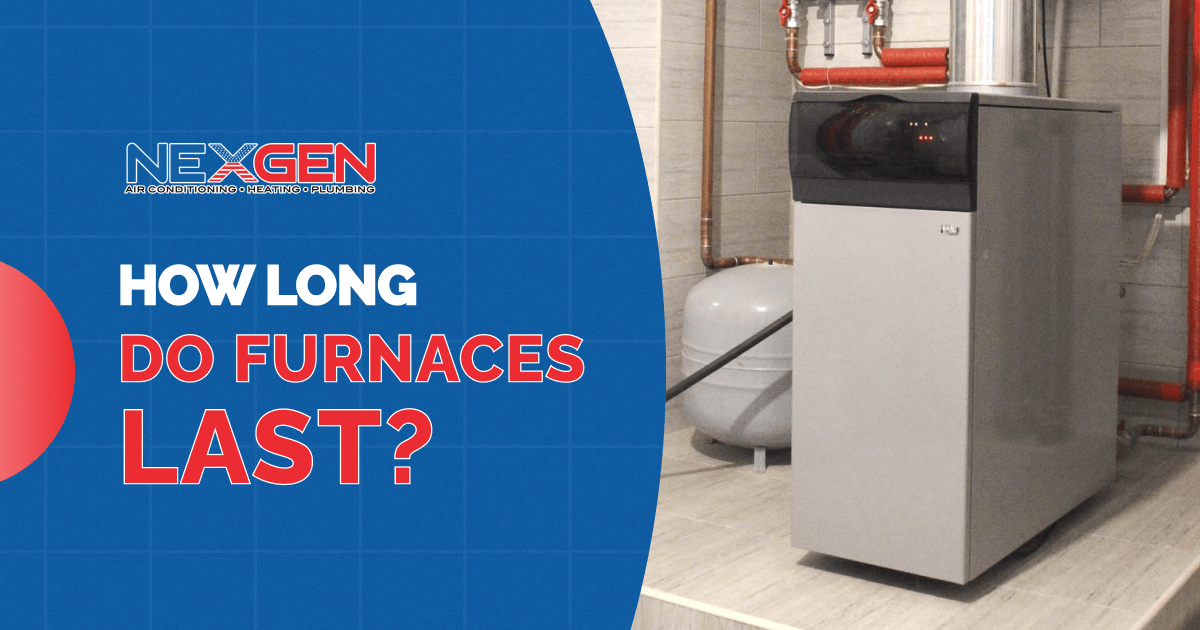
The average furnace, if well-maintained, can last 15 to 20 years. However, this is not an expiration date. A 15-year-old furnace may be running fine, but it’s wise to start shopping around to get familiar with the types of equipment available. Learning about energy-efficient options, how efficiency is calculated (such as the Annual Fuel Utilization Efficiency (AFUE) rating), and pricing/operating costs can help you plan ahead.
Average lifespan also depends on the type of furnace. Gas furnaces last only about 15 years on average. Electric furnaces tend to last longer. But it’s not unheard of for a furnace to last 30 years or more.
How Do I Get More Life Out of My Furnace?
The question, “How long do furnaces last?” is open ended when you consider the choices you can make that might extend longevity. The most important step is to have your furnace regularly maintained. Your furnace should be checked by a professional at least once a year. An inspection should include checking the gas valve, fan, heat exchanger, thermocouple, and other major parts. The pilot and burner should be cleaned and electrical and gas connections tightened. A technician will also lubricate moving parts and test the system to see how it is operating.
Other ways to extend a furnace’s lifespan include:
- Changing the air filter as recommended by the manufacturer.
- Insulating and sealing your home to reduce system strain.
- Cleaning and sealing ductwork.
Setting your thermostat up or down a few degrees can help as well. By reducing the load on your furnace, it may work less hard, so that vital components undergo less strain. You can therefore slow down wear and tear and perhaps extend the amount of time between repair and replacement jobs.
Is It Time to Replace My Furnace?
It can be hard to know how long your furnace will last. But there are signs that it may be on its last leg. Poor installation, a lack of maintenance, and improper sizing can reduce operating life significantly. Nonetheless, ignoring the following signs can mean spending more time and money trying to fix an old furnace or repairing the damage running a faulty one can cause. Here are a few reasons to consider furnace replacement:
- Noise: Popping, rattling, screeching, clicking, booming, or loud humming are red flags that your furnace needs major repairs or replacement.
- Temperature Fluctuations: If the temperature suddenly changes as you move from room to room, the furnace may not be distributing heat properly.
- High Costs: Replace any furnace that costs more than half the price of a new model to repair. If your energy costs are high, you may be dealing with an efficiency problem.
- Soot: Soot on the furnace register, as well as dust around your home, can mean too much carbon dioxide is being produced.
- Dry Air: Abnormally low humidity in your home can damage wood furniture and flooring, kill house plants, and affect your skin and respiratory health.
- Yellow Flames: The burners should produce blue flames. Otherwise, there may be a gas leak, combustion problem, or release of carbon monoxide.
Schedule Heating System Repair or Installation with Nexgen
At Nexgen, we specialize in residential heating systems. Our technicians are fully licensed and insured and will evaluate your system for free. We also offer deals, discounts, and maintenance programs to help you save, while our equipment is fully warrantied. To schedule heat pump or furnace installation, repair, or replacement, book your service appointment online or call 833-729-9735 today.
When to Replace Your Gas Furnace?
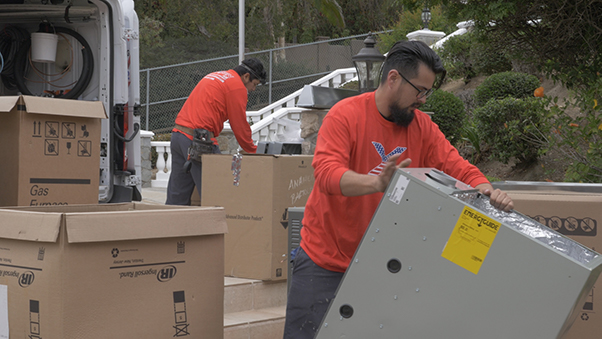
Your home furnace is one of the most important parts of your home, it is quite smart to keep track of how efficient and effective your furnace is working as time rolls on. You need to know when it is time to repair or replace your furnace. The costs of reoccurring maintenance can be quite costly and it might end up costing more than just replacing your furnace altogether. An outdated furnace can cost more than just money, as it also can pollute the air that your family is breathing. These tips will help you determine when it might be time to buy a new heating system.
When it’s time, it’s time
If your furnace is 11 years or younger and has had routine maintenance over the years then you should have nothing to worry. If your furnace is a little older then you might have seen some warning signs that it might be time to replace your furnace.
Signs of Warning
As a homeowner, it is crucial to be aware of warning signs that your appliances might be running on their last leg. Using old, outdated appliances can be costly and dangerous.
Age
The average lifespan for a furnace is around 16 to 20 years. It is crucial to have your furnace inspected regularly to keep it up and running efficiently, this will assure a long lifespan. If your furnace is nearing this age or is already at this age, it may be time to start looking for your next furnace. The new technology that furnaces now come with will shock you. Your power bill will be improved tremendously and you will also see an improvement in air quality.
Energy Bill Cost
Have you begun seeing an increase in your bill and didn’t know why? This could be because of your old furnace. Their ability to create heat is greatly diminished over the years of use. A HUGE warning sign for your furnace effectiveness and efficiency is an increase in your power bill cost & This is usually the biggest factor that pushes people over the edge.
House Temperature
Are you struggling to keep warm in the winter? Your furnace will spend hours trying to get the house warm but will never reach the desired temperatures for the different rooms in the house? This is because your furnace may be outdated and not have enough power to heat the entire house.
Newer furnaces are packed with brand-new technology to allow furnaces to be most effective. A new furnace purchase will prove to be a great investment over time because of a decreased power bill, and a perfectly heated home for a time to come. We listed a few of the warning signs that your furnace may need a new replacement. It is a big investment for your home but wasting money on repairs won’t solve any long-term problems that an old furnace has. You will not regret investing in a new piece of equipment, your home will finally feel comfortable on those cold winter nights and your power bill will see a drop in price.
Call NexGen HVAC & Plumbing
Our expertise and commitment to customer satisfaction make us the leading HVAC company in Southern California. To learn more about our equipment, services, and protection plan, book an appointment online or call 888-277-0415. company and HVAC repair technicians you know, schedule today! 833-729-9735
5 Things to Consider When Buying a Furnace

Furnaces are an essential part of your home because they provide heat for your home during the chilly winter months. When the time comes to buy a new furnace, it is best to know what things you need to consider. There are many factors that weigh into this decision, depending on your needs, you may prefer one type of furnace over another. Some of these weighing factors include efficiency, size, power source, and brand type. We will discuss these different factors below.
HVAC System Types
Home heating systems come in two common types, packaged systems or split systems. Split systems are known for having two separate units for heating and air conditioning. As the times change more and more people are moving towards the packaged system. It is a little more space conscious and allows the homeowner to only have to manage one system for both air conditioning and heating.
Your Heating Unit's Fuel Source
There are a few options available when it comes to the fuel source for your new furnace. The most common types are gas, electric and oil. Of these three, gas and electric are by far the most commonly found. Oil powered heaters are very outdated and are mostly found in older homes around the country. Gas powered furnaces are great for areas that tend to have freezing temperatures because they are typically a little cheaper than electric to operate for long hours.
Thermostat Preferences
The key to perfect temperatures throughout your home is thermostat placement. If your home seems to fluctuate in temperature depending on what room you are in, you might want to look into zoning systems. These zoning systems work by using multiple thermostats throughout your home, determining the which parts of your home truly needs heating help. This will reduce unnecessary use of heat in certain parts of your home, in effect reducing your average energy consumption.
Furnace Efficiency
There are many different types of furnaces and all are different when it comes to energy consumption. Depending on the size of your home, you may not need a huge power hungry furnace. This will really be the biggest factor in determining how large of a furnace you will need. Square footage is the biggest factor because you need your furnace to provide heat for the entire home without the need to run for hours on end.
Furnace Warranty
These days most furnace systems come with a good warranty depending on the brand you decide to go with. Frigidaire currently has a 10-year warranty on their products because of their commitment to quality products. Your local appliance store will have all the information regarding warranties.
These are just a few of the top factors involved in choosing your new furnace for your home. Just remember that there are a few more things to think about other than upfront costs when choosing a new heating system. The cost to operate a system can become a huge burden, make sure to weigh all of the top factors before jumping into a decision.
Call NexGen Today
Our expertise and commitment to customer satisfaction make us the leading HVAC company in Southern California. To learn more about our equipment, services, and protection plan,
book an appointment online or call
888-277-0415.
Broken Furnace? Here’s What You Should Do
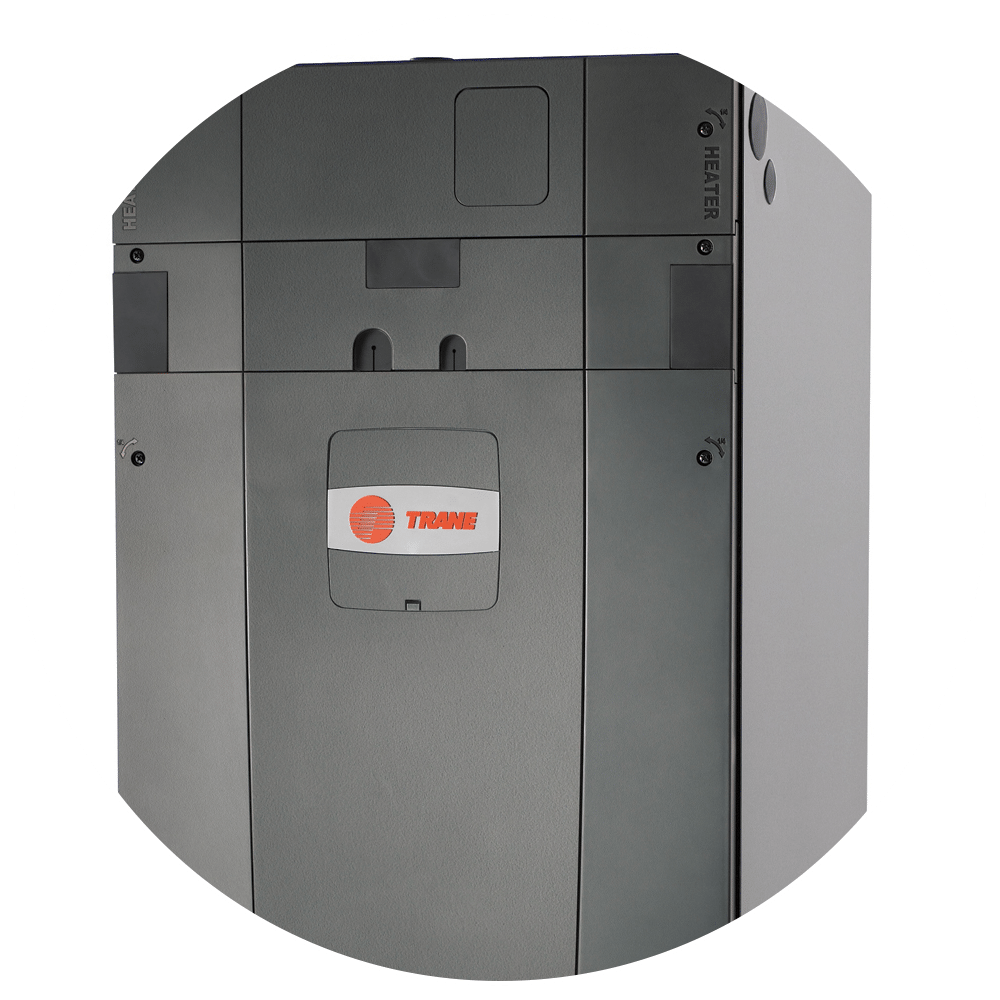
Did your heart stop working and you don’t know how to fix it? There are a few things that could stop your heat from working and we are here today to give you a few tips to diagnose your main problem.
Before you call any sort outside help, you should check to see if your furnace is actually broken or temporarily disabled because of a few fixable issues. Make sure to keep reading to discover the root problem and how you can fix them.
Air Vents
First, you must check the most obvious thing, is air flowing through your air vents into your rooms? You may need to grab a neighbor's ladder or the nearest chair depending on your ceiling height. Reach over to your vent and check to see if you feel the air. If not, try adjusting the vent angle. If this doesn’t work, see if there could be any debris blocking the vent. Sometimes lint and debris can build up in the vent causing airflow issues.
Check the Gas
Most furnaces are gas-powered and will have a pilot light inside one of the removable panels. Make sure to check the manual for the furnace if it is readily available, it will help you find the gas valve and pilot light areas. First, check to see if the pilot light is lit, if there is a lit flame then this is not the root cause of your issue. Keep reading to discover other ways to fix your heat problem.
Thermostat Issues
A lot of the time heating related issues is caused by a broken thermostat. These can become faulty and break over time. To check to see if your thermostat is working correctly try turning up or down the temperature setting and see if your furnace reacts in any way. If it does you will know your thermostat is not the cause.
Furnace Vents
Most furnaces have vents that are used for exhaust and intake. Check to see if you feel any sort of heat being exhausted from your furnace and clear any lint or debris that could be blocking potential airflow.
Furnace Filters
Changing filters is never something people put on their weekly to-do lists. Dirt and lint can build upon these filters and can cause a lot of issues with airflow. Warm air will not be able to pass through the filter and can cause the furnace to break down. Make sure to change your furnace filters every few months to assure your furnace is receiving proper filtering.
After these few tips hopefully your furnace will be back up and running in no time! If these tips did not get your heater back on, it may be time to call your local NexGen Air. We provide great quality work for a great price and promise to get your house temperature back to normal quickly.
Call NexGen Today
Our expertise and commitment to customer satisfaction make us the leading HVAC company in Southern California. To learn more about our equipment, services, and protection plan,
book an appointment online or call
888-277-0415.
10 Tips to Stay Warm if Your Furnace is Broken
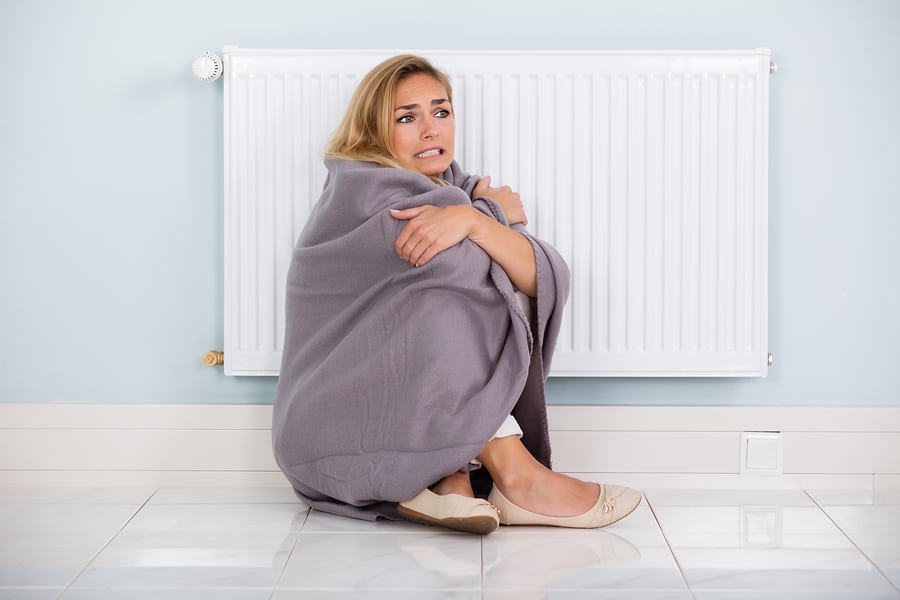
The winter season comes with many obstacles we all usually experience at one time or another; forgetting your umbrella or stepping in a rain puddle is all pretty irritating. But imagine coming home to a freezing house and a broken furnace with no hopes of being fixed until the handyman can stop by. This is a nightmare situation for anyone who needs a warm house to operate normally. Today we will discuss a few tips to stay warm and get you back and running during the tough times without an operating furnace.
Tip 1: Close All Doors And Windows
This sounds like a crazy obvious tip but it’s easier to warm up a small room than the entire house and/or neighborhood.
Tip 2: Layer Up With Clothes
Obvious tip number 2, most people do not know the correct way to layer up. The goal is NOT to end up looking like an NFL Linebacker. Start with thin layers then top with a warm jack to insulate it all. You will end up warm and looking semi-stylish.
Tip 3: Hot Food And Drinks
Make sure to skip out on the cold wedge salad on this cold evening. Heat up some warm soup or enjoy a nice cup of tea or hot cocoa to assure a warm night without the help from your friendly furnace.
Tip 4: Close Your Curtains
This is not so obvious, most people do not realize the amount of heat that gets trapped in a room by just closing your blinds and curtains. Cool temperatures radiate from the windows so it is best to block it as best as possible.
Tip 5: Staying Active
Get that heart rate up! Getting the blood pumping will raise your body temperature allowing you to warm up. Do a few push-ups and sit-ups and enjoy the natural heat.
Tip 6: Bundle Up And Watch A Movie
If you are not in the mood to be an active type, try jumping under the blankets and watching a movie. Getting under the covers and deep into a movie will for sure cause you to forget about all of your furnace troubles.
Tip 7: Clean Socks
Everyone loves a clean, warm pair of socks! Make sure to change your socks and enjoy the sudden warmth of new socks around your feet. Socks are something we all love during the cold winter.
Tip 8: Have A Party
One thing that will assure a warm home is a house party! Invite over some of your friends and watch the room temperature rise. Everyone loves a good social hour, so why not use your friends for some good?
Tip 9: Hot Pads and Heated Blankets
Try a hot pad or heated blanket when going to bed! Putting a hot pad at your feet before bed will keep you warm 100% of the time. Or another option is a heated blanket, these do wonders and usually are not too costly at the local store.
Tip 10: Plugin Space Heaters
In the twenty-first century, people often forget that we still have the ability to use space heaters. These will work well to heat up a small bedroom or living room when your furnace is not working.
Call NexGen Today
Our expertise and commitment to customer satisfaction make us the leading HVAC company in Southern California. To learn more about our equipment, services, and protection plan,
book an appointment online or call
888-277-0415.


















